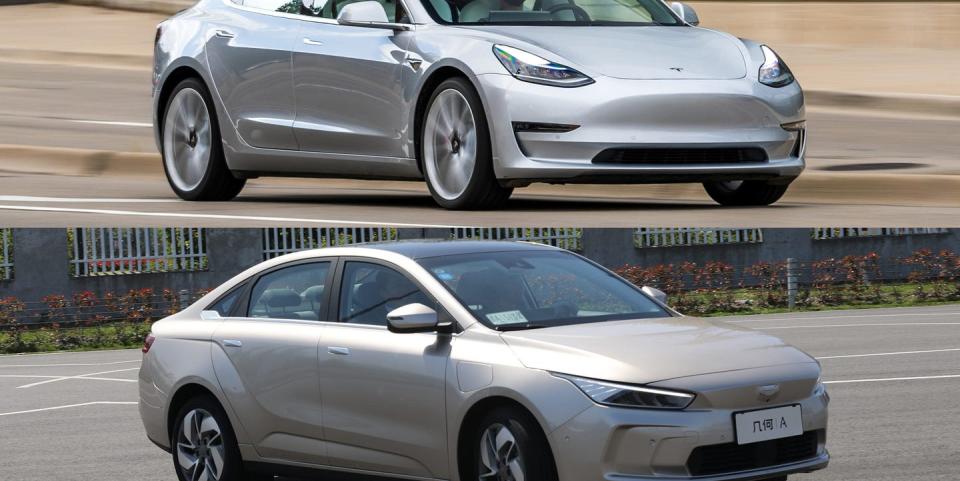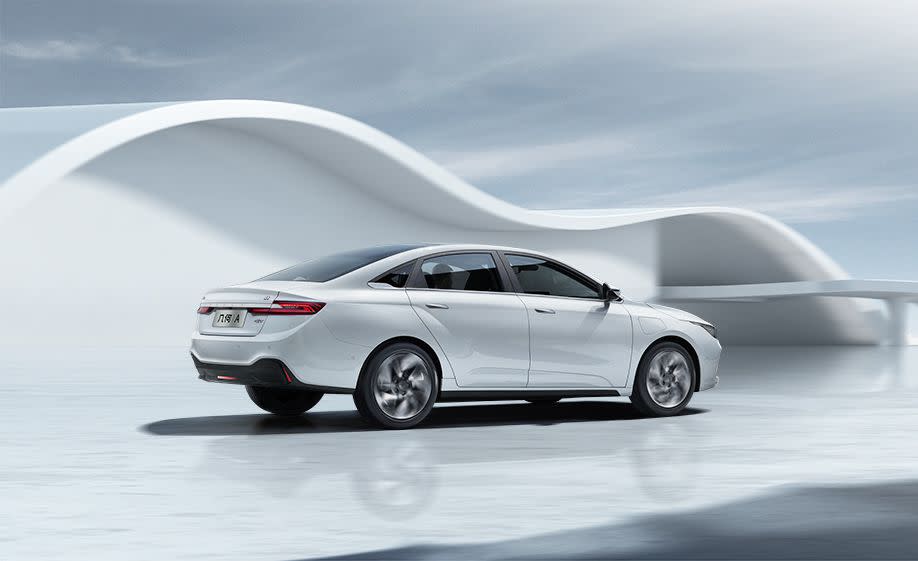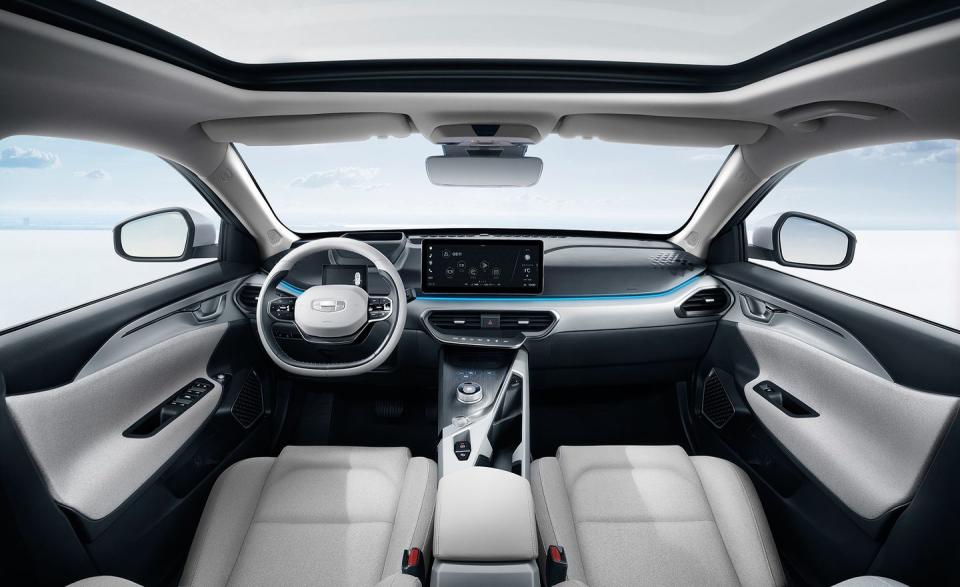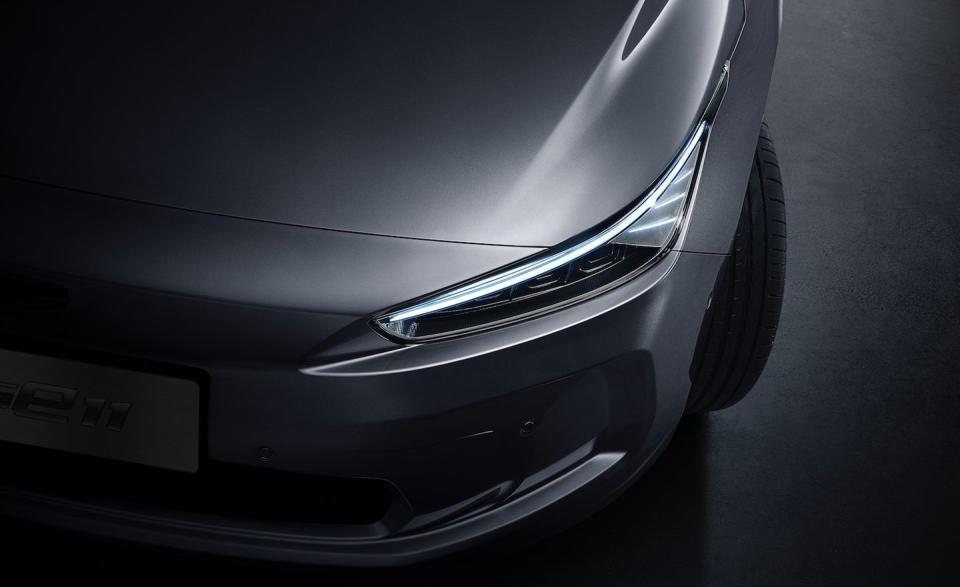How Does the Geely Geometry A Measure Up to the Tesla Model 3?

Major Chinese automaker Geely has launched a sub-brand it's calling Geometry.
The electric Geometry A is the first production model, and Geely says it's got the Tesla Model 3 in its sights.
We drove a prototype and found that, while its performance can't approach that of the Tesla, there are other enticements, including price.
Tesla might be struggling with bringing the long-promised $35,000 version of the Model 3 to market, but Chinese automaker Geely is suffering from no such problems with the Geometry A, the first production car from what is set to be a wider EV sub-brand. It was unveiled at the Shanghai auto show, but even before its debut Car and Driver had driven a prototype, albeit briefly and on a short, tight test track at Geely's Hangzhou Bay R&D center.
While the 161-hp Geometry A's performance can't get close to the straight-line shock and awe of even the least powerful Model 3, the idea is to offer Chinese buyers a similar upmarket feel and an equally connected driving experience. A total of 10 Geometry models will be launched by 2025, with all being electric, and Geely auto CEO An Conghui told journalists at the show that the A has been benchmarked against the Model 3.
Pricing
In China, the only market where it is currently on sale, the Geometry A comes with very attractive pricing. Two different lithium-ion battery packs are offered, which is similar to the Model 3's offer of a Standard and Long Range battery pack. There are also three different trim levels. Pricing will sound familiar to those watching the Model 3 and its machinations around a "$35,000" car. The Geometry A in China starts at the rough equivalent of $31,500 for the standard-range car and rises to the equivalent of $37,500 for the fully equipped long-range version. Factor in China-market EV subsidies, and those prices are reduced by as much as $15,000.
Tesla has said it will start to produce the Model 3 in China later this year, but at the moment cars sold there are being imported from the United States and are therefore still subject to import tariffs. The cheapest car currently offered there is the rear-wheel-drive Long Range car, priced in China at just under $65,000.

Design
Geely's design team is led by Peter Horbury, who is British and previously held senior roles at both Volvo and Ford. The Geometry A's stance and proportions are unradical, apart from the lack of exhaust tailpipes and a conventional radiator aperture; nothing in its appearance says it is not running on internal combustion. But the details are strong and, up close, it looks both sleek and upmarket with active door handles that motor outward when the car is unlocked, similar to those used on the Range Rover Velar and Evoque.
At 186.5 inches in length, the Geometry is 1.7 inches longer than the Model 3, although its wheelbase, at 106.3 inches, is 6.9 inches shorter. If Geely-supplied specifications are to be believed, the Geometry A weighs about 3650 pounds, which is approximately 250 pounds lighter than the rear-drive Model 3 we tested.
The Geometry A's cabin is impressive for a China-market car in this price range, with quality plastics, some metal trim, and a minimalist user interface. The Geometry A does have two digital display screens: a small one behind the steering wheel that relays details of speed, charge level, and fuel economy, plus a larger touchscreen in the center of the dashboard that runs most functions. The Geometry also gets a "voice assistant," although our test car only understood Mandarin, limiting our ability to explore its ability to take charge of various functions.

While the Geometry lacks the 3’s huge touchscreen, perceived quality in the cabin is every bit as high as it is in the Tesla, which has been criticized for its own minimalist interior. There is also generous space both front and rear, with plentiful room for adults in back as well as a generously sized trunk beneath the rear decklid.
Performance
We didn't have a Model 3 available for a head-to-head driving evaluation, but even without direct comparison we can confidently state the Tesla has nothing to fear from the Geometry A in terms of performance. The Geely is powered by a permanent-magnet synchronous AC motor that turns the front wheels through an open differential. Along with the 161 horsepower, the motor puts up 184 lb-ft of torque and will spin up to 12,000 rpm. That's significantly less power than a Tesla Model 3 Standard Range Plus, which produces 283 horsepower.
On the test track, the Geometry felt sprightly but some way short of fast. Geely’s quoted 8.8-second zero-to-60-mph time means it is slower off the line than a Nissan Leaf or a Chevrolet Bolt EV, let alone a Model 3, which Tesla claims gets from zero to 60 mph in 5.3 seconds in its least powerful form. The A's digital speed display was reading 81 mph at the end of the test track's longest straight, at which point felt acceleration had really tailed off. Geely quotes a 93-mph top speed, but it is obviously a car designed to work at the considerably lower velocities of China’s traffic-clogged roads.
The test track's collection of low-speed corners also highlighted the Geometry's equally modest levels of athleticism. There was lots of body roll and tire scrub, very limited front-end bite, and even the unmistakable sensation of torque steer despite the track's smooth surface.
Pluses? Well the Geometry’s cabin stayed impressively quiet even at higher speeds, and the soft suspension settings dealt well with the few bumps we could find. Standard equipment for the Geely includes adaptive cruise control and lane-keeping assist, which, although short of the smarts of Tesla's Autopilot, had no trouble keeping it running down a well-marked lane.

Range
Here we encounter the problem of different testing methodologies. Geely has only given us the figures for the Geometry A extracted under the flattering and mostly replaced NEDC testing protocol, with 310 miles for the long-range battery pack and 255 miles for the regular one.
Tesla hasn’t issued NEDC numbers for the Model 3, denying a direct comparison, although the least-rangey model in the current lineup is the standard rear-driver with a 240-mile EPA rating. Given the discrepancy between previous NEDC and EPA numbers, we would be surprised if the real-world figures weren’t much closer, or even in the Tesla’s favor. Using Tesla's Supercharger, the standard battery can be charged to 150 miles of range in 30 minutes, Tesla says. Geely hasn’t revealed the peak charging speeds that the Geometry will support but says it will be possible to take the battery from 30 percent to 80 percent in 30 minutes.
The Geometry brand is clearly intended for China, but Geely does say it will be launched elsewhere. There are already plans for a limited introduction to Europe, which will most likely be done through ride-hailing and possible car-sharing fleets. The electrified GE platform that the Geometry A sits on is not intended to come to the U.S., but the more advanced Pure Electric Modular architecture that will follow it will underpin U.S.-bound models from Polestar, Volvo, and Geely’s millennial-focused sub-brand Lynk & Co.
('You Might Also Like',)

 Yahoo Autos
Yahoo Autos